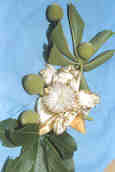Mirabilis Jalapa is a perennial flowering plant from the most commonly grown ornamental species Mirabilis. These flowers have a peculiar aspect to bloom after 4:00 p.m. hence it is commonly called as Four O'clock flower. Hummingbirds and butterflies are attracted to this fragrant flower. The flowers bloom during evening due to drop in temperature and not because of time. If you live in a tropical region then why not grow this beautiful night flower in your garden.
(1) Vital statistics of Four O'clock flower:
Botanical Name : Mirabilis Jalapa
(In Latin "Mirabilis" means "wonderful" and "Jalapa" is the "name of a town in Mexico").
Common Names : Four O'clock, Beauty-of-the-night, Marvel of Peru
(In Latin "Mirabilis" means "wonderful" and "Jalapa" is the "name of a town in Mexico").
Common Names : Four O'clock, Beauty-of-the-night, Marvel of Peru
Class
: Magnoliopsida
Order
: Caryophyllales
Family
: Nyctaginaceae
(2) Four O'clock plant description:
The plant grows upto 2-3 feet tall and just as wide. The stem of the plants are succulent.Leaf :
The leaves of four O'clock flower oval shaped and slightly pointed.
Flower :
(1) The four O'clock flower is trumpet shaped.
(2) The four O'clock flower is 2 inch long and 1inch across the end.
(3) The four O'clock flower have calyx but no petals.
(4) An individual flower can have broken or bi-color. Four o'clock flowers are typically pink, red, white, magenta, yellow, cream and bi-colored.
(5) One plant can have flowers of different colors simultaneously.
(6) As the plant matures it has a peculiar aspect to change color. E.g. pink flower variety plant can change gradually to white color.
(7) The flowering season is from July to October.
(8) The flowers bloom after 4:00 p.m giving a sweet scented fragrance
(9) The Mirabilis Jalapa flowers are hermaphrodite i.e. they have both male and female organs. They are pollinated by Insects.
Seeds :
The fruit is single seeded. The matured seed is black, spherical in shape and wrinkled surface. The seed is extremely poisonous.
(3) Place of Origin/ Habitat of Four O'clock Plant:
Four
O'clock flower is native to tropical South America. Nowadays you can
find these flowers both in tropical and temperate regions. It is
believed that Four O'clock flower has been exported from the Peruvian
Andes in 1540.
(4) Tips to grow Four O'clock flower:
The bloom season is from July to October that is from summer to fall season.
Propagation :
Four O'clock flower can be grown using a seed or tuber.
Plant the seeds during the spring or four weeks before summer season in a pot in shade and shift the pant to a sunny place after the frost has gone. Plant the seeds 12 inches apart.
Tip: Soak the seeds overnight in water before planting to germinate faster.
Plant the tuber when the summer season starts. If you live in a temperate region; after September when the plant has stopped flowering lift the tuber and store it in a frost free area for the next season possibly April when the summer season starts.
Soil Type : Sandy, loamy or clay soil
Sun Exposure : Full sun to partial shade
Soil Moisture : Moist, well-drained
Pest :The leaf is susceptible to rust.
Pick the seeds often so that this flowering plant doesn't become a weed in your garden.
Propagation :
Four O'clock flower can be grown using a seed or tuber.
Plant the seeds during the spring or four weeks before summer season in a pot in shade and shift the pant to a sunny place after the frost has gone. Plant the seeds 12 inches apart.
Tip: Soak the seeds overnight in water before planting to germinate faster.
Plant the tuber when the summer season starts. If you live in a temperate region; after September when the plant has stopped flowering lift the tuber and store it in a frost free area for the next season possibly April when the summer season starts.
Soil Type : Sandy, loamy or clay soil
Sun Exposure : Full sun to partial shade
Soil Moisture : Moist, well-drained
Pest :The leaf is susceptible to rust.
Pick the seeds often so that this flowering plant doesn't become a weed in your garden.













